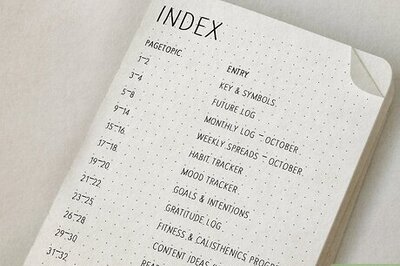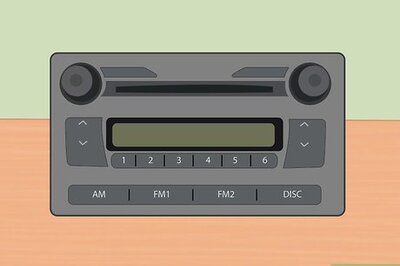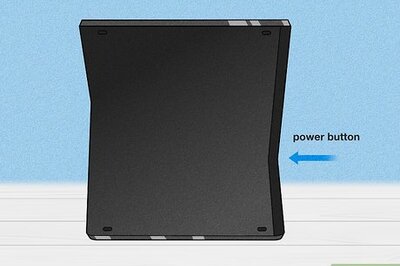
views
What is the Golden Ratio in facial aesthetics?
The Golden Ratio is an equation that defines the ideal facial proportions. The Golden Ratio, (also known as Divine Proportion), is 1.618 and often represented by the Greek letter ᵠ (phi). The Golden Ratio has its origins in Ancient Greek mathematics, and the theory is that a face with a length that is approximately 1.618 times its width is the ideal ratio when it comes to facial proportions. The theory also applies similar proportions to other parts of the face, like the eyes, nose, and mouth. Many cosmetologists and cosmetic surgeons use the Golden Ratio as a baseline for the ideal facial structure. The Golden Ratio serves as a guide for balance and proportions in your face, not as a beauty measurement.
How to Calculate the Golden Ratio of Your Face
Measure your face's length and width. Use a ruler or tape measure to measure the length and width of your face in inches or centimeters. Measure the length first, then the width, and mark them both down on paper or in your phone. Then, divide the length of your face by the width. If the result is around 1.618, the width and length of your face are the Golden Ratio.
Measure the distance between your eyes and your eye width. Use a ruler or tape measure to measure the distance between your eyes and the width of one of your eyes in inches or centimeters. Once you’ve got both measurements, mark them down and divide the eye distance by the width of a single eye. If the result lands on or near 1.618, your eye spacing has a Golden Ratio.
Measure the width of your nose and nostrils. Use a ruler or tape measure to measure the width of your nose and the width of your nostrils in inches or centimeters. Mark the measurements down, then divide the width of your nose by the width of your nostrils. If the calculator spits out 1.618, your nose width has a Golden Ratio.
Measure the width of your mouth. Use the ruler or tape measure to measure the width of your mouth in inches or centimeters. Once you’ve got that measurement, grab the measurement of your nose width and divide your mouth width by it. If it comes out to 1.618, the width of your mouth has a Golden Ratio.
Alternatively, take a Golden Ratio test. If you prefer an easier process, there are plenty of AI programs that do the work for you. From programs like FaceRate.ai and PinkMirror to apps like Beauty Scanner - Face Analyzer, these AI-based programs take images of your face, analyze them with AI, and let you know what the ratio of your face is. Some programs even tell you how the ratio of your face compares to the Golden Ratio. If the program you use doesn’t tell you how the two ratios compare, compare them yourself by seeing how your measurements line up with the 1.618 figure. We even have beauty tests here at wikiHow!
How to Achieve the Golden Ratio
Facelift A facelift is a surgical procedure that removes excess facial tissue and lifts any sagging skin in the lower section of the face, giving the illusion of youth and adjusting the proportions of your face. Facelifts also look a lot more natural than they did when they were first invented, making them a viable option for changing the proportions of your face without veering away from the natural look. According to board-certified plastic surgeon Edward S. Kwak, MD, “good cosmetic outcomes should look natural.” This is achieved in the face by finding balance and harmony with the different parts of the face.
Filler Injections Filler injections like lip or dermal fillers add more volume to your lips and portions of your face, like the cheeks, chin, jawline, and other areas. Using filler injections is a great way to change the proportions of your face through non-surgical methods. Filler injections aren’t typically permanent, though, which means you need to get periodic injections to maintain the look. Using too much filler can make your face look rounder, giving you a look known as pillow face. Pillow face can also be caused by incorrectly placed or low-quality filler.
Botox Botox (formally known as botulinum toxin injections) is another non-surgical procedure that involves injections. These injections are around the forehead and brows and are used to treat wrinkles and expression lines in those areas. Botox also helps raise the eyebrows and lower the space between the brow and the hairline, influencing your forehead proportions. According to board-certified dermatologist Aanand Geria, there is a risk of bruising when you inject a needle into the skin, but it isn’t common. If it does occur, the bruising typically takes a week or two to go away.
Creams, lotions, facials, and chemical peels Applying creams and lotions to your skin helps keep it moisturized and youthful, maintaining a smooth, hydrated look with reduced wrinkles and sagging. Creams, lotions, facials, and chemical peels all help get rid of dead skin cells or layers to a degree, promoting new growth, smooth skin, and youthful facial proportions.
Microneedling Microneedling is a procedure where thin needles are used to make small holes in the top layer of your skin. These holes stimulate the skin’s healing process, resulting in the increased production of collagen and elastin, two proteins that help keep your skin smooth and firm. It can tighten up your skin if it’s loose, tightening up your facial proportions by extension. There are also more extensive cosmetic options, like laser skin resurfacing, available. Laser skin resurfacing is a procedure that uses an energy-based device to reduce fine lines, age spots, and uneven color, improving the look and feel of the skin.
Other Ways the Golden Ratio Is Used
The Golden Ratio is used in art and graphic design to determine ideal spacing. The Golden Ratio has been found in famous historical works, like the Mona Lisa and the Great Pyramid of Giza. Artists and graphic designers of today follow in the historical footsteps, using the Golden Ratio to inform the composition of their work and guide them so everything stays balanced and even.
Photographers use the Golden Ratio to achieve a natural composition. The Golden Ratio creates a photograph that is pleasing to the human eye by composing things in a natural spiral, which is the result of the Golden Ratio equation when applied to physical space (like the Fibonacci Spiral). A photographer using the Golden Ratio may compose the image so the spiral leads you to what they want you to see, starting with a building in the midground, going to the yard in the foreground, and finishing with a skyline in the background.
The Golden Ratio appears as spirals in nature. Visually, the Golden Ratio results in a natural spiral that’s all over nature. From the curling tail of a lizard to the spiraling stars of our galaxy, the Golden Ratio regularly appears all over the natural world, serving as one of its many beauties.
Do you need the Golden Ratio to be attractive?
No, because beauty is subjective! The Golden Ratio is just a guide for optimal facial proportions, but it doesn’t define beauty! Beauty is anything that’s pleasing to your senses or your mind, and what’s pleasing is different for everyone! Beauty isn’t just about aesthetics or having the proper facial proportions; it’s subjective! Which means everyone is attracted to different things.
What factors make a person attractive?
Beauty is ultimately in the eye of the beholder. Everyone’s standard of beauty is different. Some people value physical attraction, like a symmetrical face, a nice outfit, and a fresh haircut, while others value mental attraction, like stimulating conversations and unique perspectives. Although there are conventional beauty standards in different social spaces, people’s opinion of beauty is ultimately based on their attractions and experiences.
Some people value skin quality. Many people are attracted to people with smooth, youthful skin, and although beauty standards have changed over the years, a youthful appearance has remained favorable when it comes to beauty and attractiveness. It’s important to note, though, that everyone has different standards of beauty, so there are people out there who are attracted to a more mature look, too!
Others value a good personality. For many people, a person's attractiveness is rooted in personality traits like a sense of humor, honesty, loyalty, and so on. A person can be objectively attractive, but if their personality is off-putting, it affects how others see them and significantly reduces their attractiveness.
An ability to make your partner feel passionate is also important. Dating coach Hardy Jean says that a woman’s ability to ignite passion in the person she’s talking to makes her irresistibly attractive. Ignite that passion by pursuing the person you’re talking to as much as they’re pursuing you, being spontaneous, supportive, and respectful while also keeping them on their toes, and challenging them to be better versions of themselves.
Frequently Asked Questions
Is the Golden Ratio the only measure of facial beauty? No, there are other measurements of facial beauty, too, and they depend on the person. For example, one person may be attracted to people with thin, chiseled faces, while another person may be attracted to people with chubby, round faces. Their measurements of facial beauty are different based on their preferences, as they’re likely comparing people to the aforementioned qualities. Beauty is subjective.
Can the Golden Ratio be used to improve facial appearance? Understanding the Golden Ratio can help you make more informed decisions about how you want to style your hair, do your makeup, and alter your face. It can also be used as a guide for achieving balanced proportions, but beauty is subjective, so improvement is different for every person. The Golden Ratio is mainly used as a way to enhance your features, rather than a benchmark for what work needs to be done to hit that 1.618 figure.
How often should I measure my face for the Golden Ratio? Facial proportions tend to remain stable in adults, but as you age, they do change, as the fat in your face loses volume and droops downward to the lower half of the face. So, whenever you notice any significant changes in your facial features, like droopy skin or a fatty neck, measure your face to see if it still has a Golden Ratio.
How can I use my face measurements to my advantage? If you have a Golden Ratio, use that to boost your confidence and remind yourself that you’re conventionally attractive. If not, use your measurements to help determine your face shape and figure out what works best for it, like types of haircuts, styles, and accessories.



















Comments
0 comment